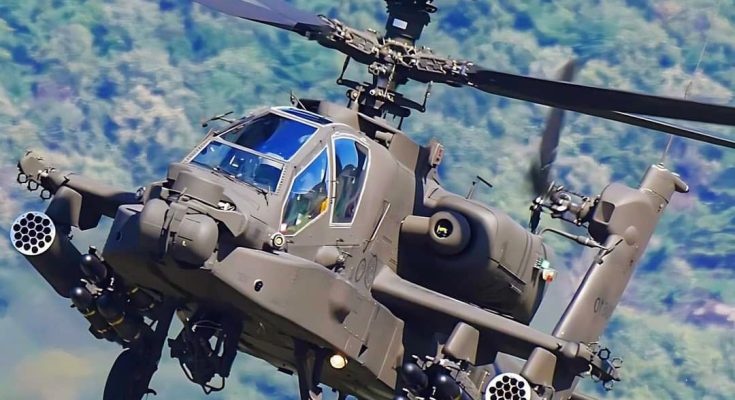The U.S. Navy’s “Sea Apache” Helicopter Project was an ambitious attempt to develop a versatile and powerful naval helicopter that could serve in a variety of roles, including anti-submarine warfare, search and rescue, and strike missions. The project revolved around adapting the highly successful AH-64 Apache, an attack helicopter originally developed for the U.S. Army, to meet the demanding requirements of naval operations. However, despite initial enthusiasm, the project ultimately never took off. Understanding the reasons behind the failure of the Sea Apache project requires exploring its origins, challenges, and the factors that led to its cancellation.
The Origins of the Sea Apache Project
The AH-64 Apache, developed by McDonnell Douglas (now part of Boeing), was one of the most successful and deadly attack helicopters ever built. Since its introduction in the 1980s, it had proven itself as an exceptional weapon system, capable of engaging a wide range of targets, from enemy tanks to helicopters. The U.S. Army adopted it for its ability to operate in all weather conditions and deliver precision-guided munitions. Given the Apache’s proven capabilities, the U.S. Navy began to explore the possibility of adapting the Apache for naval operations in the late 1980s and early 1990s.
The idea was to create a helicopter that could perform both attack and reconnaissance missions while operating off of naval ships. The Navy sought a rotorcraft that could provide anti-ship and anti-submarine warfare capabilities, along with the ability to operate from smaller ships, such as destroyers and frigates. This led to the formation of the Sea Apache project, which aimed to modify the Apache for use on aircraft carriers and smaller vessels.
Design Challenges and Modifications
In order to adapt the Apache for naval use, significant design changes were necessary. A naval version of the Apache would need to be capable of operating in saltwater environments, which presented challenges in terms of corrosion resistance, as well as in terms of catapult launches and vertical landings on ships. The Apache’s design, originally tailored for land-based operations, was not inherently suited for these demands.
Key modifications were considered to enable the Apache to operate on ships. These included making the helicopter more compact for easier storage on naval vessels, reinforcing its landing gear for shipboard operations, and integrating advanced anti-submarine and anti-ship weaponry. While the Apache had excellent firepower and avionics, these changes would significantly increase the complexity and cost of the program.
Moreover, the Sea Apache was expected to share some components with the SH-60 Seahawk, the U.S. Navy’s primary helicopter at the time, to ensure compatibility with existing naval systems and ease of maintenance. However, the Seahawk already performed many of the roles that the Sea Apache was designed for, making it difficult to justify the cost of creating a new helicopter with similar capabilities.
Budget Constraints and Competition
By the early 1990s, the Cold War had ended, and defense budgets were being scrutinized for efficiency. The Sea Apache was seen as an expensive and complex program that might not deliver the necessary benefits to justify its high costs. The Apache’s modifications would be expensive, and the Navy was already heavily invested in other helicopter programs, including the Seahawk and the V-22 Osprey tiltrotor, which promised greater versatility and longer range.
Additionally, during the 1990s, the U.S. Navy’s focus shifted toward the development of more stealthy and advanced combat systems, including unmanned aerial vehicles (UAVs) and long-range cruise missiles. These technologies were seen as more capable alternatives for naval operations, making the Sea Apache less attractive as resources were allocated elsewhere.
The Navy also realized that adapting a land-based helicopter like the Apache for naval use was an overly ambitious task. The complexity of modifying the Apache to meet naval requirements, combined with its high cost and the lack of a clear operational necessity, led to a re-evaluation of the project.
Program Cancellation
In the end, the Sea Apache project was canceled in the mid-1990s, with the Navy opting to continue with more traditional rotorcraft like the SH-60 Seahawk and explore other technologies for naval operations. The Navy’s decision was based on the realization that existing helicopters could fulfill the required roles, and emerging technologies would likely provide superior capabilities in the future. Moreover, the Apache’s design, though highly effective in land combat, was not optimally suited to the specific needs of naval warfare.
Legacy and Lessons Learned
While the Sea Apache project did not materialize, it provides important lessons in the development of military technology. The program’s cancellation highlighted the complexities of adapting land-based systems for naval environments, and it underscored the need for flexibility and cost-effectiveness in military procurement. Additionally, the Sea Apache’s failure reinforced the importance of ensuring that new technologies offer clear operational advantages over existing systems.
Though the Sea Apache never entered service, the AH-64 Apache remains a potent force in the U.S. Army’s arsenal, and its capabilities continue to be refined for modern combat operations. Meanwhile, the U.S. Navy has continued to rely on specialized naval helicopters like the SH-60 Seahawk and newer, more advanced technologies for its missions.
Ultimately, the Sea Apache serves as a reminder that not every promising concept can be translated into a successful operational system. Some ideas are ahead of their time, and others are simply too costly or impractical to succeed. In the case of the Sea Apache, the Navy chose to focus its resources on solutions that better met its evolving needs in the post-Cold War world.



